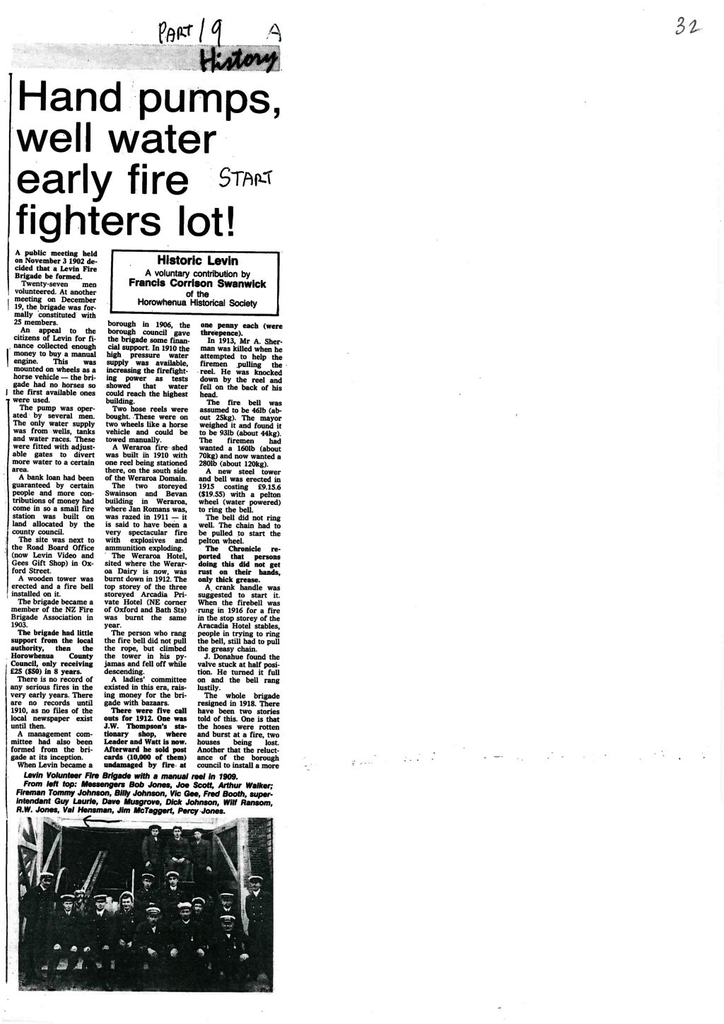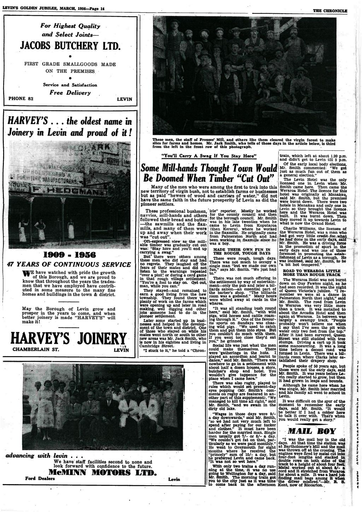History of the Levin Fire Brigade
- Description
Twenty-seven men volunteered. At another meeting on December 19, the brigade was formally constituted with 25 members.
An appeal to the citizens of Levin for finance collected enough money to buy a manual engine. This was mounted on wheels as a horse vehicle - the brigade had no horses so the first available ones were used.
 The pump was operated by several men. The only water supply was from wells, tanks and water races. These were fitted with adjustable gates to divert more water to a certain area.
The pump was operated by several men. The only water supply was from wells, tanks and water races. These were fitted with adjustable gates to divert more water to a certain area.Photo at left shows the Levin brigade with a manual pump in about 1903. The first fire station was built in 1902 where Michael's Hairdressers in Oxford Street is now.
A bank loan had been guaranteed by certain people and more contributions of money had come in so a small fire station was built on land allocated by the county council.
The site was next to the Road Board Office (now Levin Video and Gees Gift Shop) in Oxford Street.
A wooden tower was erected and a fire bell installed on it.
The brigade became a member of the NZ Fire Brigade Association in 1903.
The brigade had little support from the local authority, then the Horowhenua County Council, only receiving £25 ($50) in 8 years.
There is no record of any serious fires in the very early years. There are no records until 1910, as no files of the local newspaper exist until then.
 Photo on left shows the Volunteer Fire Brigade with a manual reel in 1909.
Photo on left shows the Volunteer Fire Brigade with a manual reel in 1909.From top left: Messengers Bob Jones, Joe Scott, Arthur Walker;
Firemen Tommy Johnson, Billy Johnson, Vic Gee, Fred Booth, superintendent Guy Laurie, Dave Musgrove, Dick Johnson, Wilf Ransom, R.W. Jones, Val Henseman, Jim McTaggert, Percy Jones.
A management committee had also been formed for the brigade at its inception.
When Levin became a borough in 1906, the Borough Council gave the brigade some financial support. In 1910 the high pressure water supply was available, increasing the fire fighting power as tests showed that water could reach the highest building.
Two hose reels were bought. These were on two wheels like a horse vehicle and could be towed manually.
A Weraroa fire shed was built in 1910 with one reel being stationed there, on the south side of the Weraroa Domain.
The two storied Swainson and Bevan building in Weraroa where Jan Romans was, was razed in 1911 - it is said to have been a very spectacular fire with explosives and ammunition exploding.
The Weraroa Hotel, sited where the Weraroa Dairy is now, was burnt down in 1912. The top storey of the three storied Arcadia Private Hotel (NE corner of Oxford and Bath Sts) was burnt the same year.
The person who rang the fire bell did not pull the rope, but climbed the tower in his pyjamas and fell off while descending.
A ladies’ committee existed in this era, raising money for the brigade with bazaars.
There were five call outs in 1912. One was J.W. Thompson’s stationery shop, where Leader and Watt are now. Afterward he sold post cards (10,000 of them) undamaged by fire at one penny each (were threepence).
In 1913 Mr A. Sherman was killed when he attempted to help the firemen pulling the reel. He was knocked down by the reel and fell on the back of his head.
The fire bell was assumed to be 46lb (about 25kg). The mayor weighed it and found it to be 93lb (about 44kg). The firemen had wanted a 160lb (about 70kg) and now wanted a 280lb (about 120kg).
A new steel tower and bell was erected in 1915 costing £9.15.6 ($19.55) with a Pelton wheel (water powered) to ring the bell. The bell did not ring well. The chain had to be pulled to start the Pelton wheel. The Chronicle reported that persons doing this did not get rust on their hands, only thick grease.
A crank handle was suggested to start it. When the fire bell was rung in 1916 for a fire in the top storey of the Arcadia Hotel stables, people trying to ring the bell, still had to pull the greasy chain. J. Donahue found the valve stuck at half position. He turned it full on and the bell rang lustily.
The whole brigade resigned in 1918. There have been two stories told of this. One is that the hoses were rotten and burst at a fire, two houses being lost. Another that the reluctance of the borough council to install a more powerful Pelton wheel to ring the bell.
A brigade was formed by John Milne, a former fireman, of councillors and residents. Reason prevailed and a fire board of councillors and residents ran the brigade in 1919.
In 1921, a new 1920 Model T Ford was bought. This proved very unreliable with hard starting and slowness. Children could race it on their bikes. For 14 years it was troublesome – pleas by the firemen for a new fire engine were ignored by the board as the engine was only 14 years old. Some repairs were carried out, improving its performance and it lasted till 1939, when a V8 Ford pumper was bought.
To the firemen this was something out of this world
A new fire station was built in 1921 in Queen Street with better working and social facilities. A duplex system of fire alarms, with six alarms about the town.
In 1953 a new V8 Ford Pumper fire engine was bought. It was closed in so the firemen were protected from the elements. It held a 150 gallon tank (675l).
A trailer pump was obtained in 1955 giving the brigade three pumping units.
The fire station was remodelled and extended in 1962. The engines were stored in a primitive shelter for nine months. An appliance bay, capable of holding four appliances was provided along with a social room, billiard room, kitchen and dinette.
Nineteen hundred and sixty four brought a Commer Pumper appliance into the fleet and a new International V8 was added.
A new fire siren was installed, the original going to the Weraroa Domain and another on the Marine Reserve in 1968.
In the 1960s, the area covered by the Levin Brigade was extended to Potts Hill, Whirokino Bridge and Manakau.
The brigade celebrated its 75th Jubilee in 1977, with a procession, bonfire and functions.
Nineteen hundred and sixty seven brought the installation of two way radio in the station and appliances.
The beginning of private automatic alarms to the station came in 1966 with 25 buildings being connected by 1977. About this time, three custodian firemen were employed on a 40 hour week and the 111 telephone alarm system was introduced about the same time.
The Fire Police Corps was formed in 1929 and existed until 1943 when shortage of manpower during World War II caused a recess. It was reformed in 1951.
The present fleet of fire trucks consists of 1981 Dodge, 1988 International and a 1988 Volvo.
The fire station was partly demolished in 1982 and rebuilt – the remainder demolished in 1983 and rebuilt. Now the station is very modern with first -class facilities. The brigade has been administered since 1976 by the NZ Fire Service, as are all brigades in NZ.
Some major fires recorded in recent years were the Beaven Box Factory, Grand Tavern in 1981, NZ Wallpaper Factory – 1964, Hirst Caravan Factory in early 1970s and the Wishart Factory in 1989.
Men at the top
The designations of head officers of the brigade have changed over the years.
From 1880 to 1918 they were called captains and lieutenants, from 1918 until 1949 superintendents and deputy superintendents and from 1949 Chief Fire Officer and Deputy Chief Fire Officer.
Levin’s fire chiefs have included:
Captain J.H. Leonard, Dec 1902 – Oct 2, 1905;
H. Anstice, Oct 3 1905 – June 22 1908;
R.H. Jones, Jun 23 1908 – Jan 30, 1911;
J. McTaggett, Jan 30 1911 – June 21 1918 ;
J.C. Milne, June 22 1918 – July 31, 1919.
Superintendent W.B. McIntosh, Aug 1, 1919 – July 31 1920;
A.P. Jones, Aug 1, 1919 – Jul 31, 1920;
A.P. Jones, Aug 1 1920 – July 6, 1921;
C.W. Shaw, July 6, 1921 – May 31, 1931.
Acting Superintendent J. McTaggett, June 1, 1923 – June 22. 1923.
Superintendent J.E. Conner, June 22, 1923 – May 30, 1928;
F.C. Booth, April 1, 1928 – July 31, 1930;
M. Sutherland, Aug 1, 1930 – Feb 14, 1937;
R.H. Johnson, Feb 14, 1937 – Sep 14, 1938.
Chief Fire Officer W.S. Salmons, Sep 15, 1938 – April 30, 1959;
L.V. Trass, May 1, 1959 – April 30, 1974;
A.J. Easton, May 1 1974 – 1982; B.D. Hassell.
Deputies have included:
Lieutenant F.E. Wilson, Dec 9, 1902 – June 14, 1914;
H. Anstice, June 15, 1904 – Oct 2, 1905;
R.J. Jones, Oct 3 1905 – June 22, 1908;
R.H. Johnson Sen, June 23, 1908 – June 21, 1918;
W. McIntosh, June 22, 1918 – July 31, 1919.
Deputy J. Young, Aug 1, 1919 – July 31 1920;
J.E. Connor, Aug 1 1920 – June 22, 1923;
E.P. Blacklaws, June 22, 1923 – March 27, 1925;
F.C. Booth, March 28, 1925 – April 1 1928;
W. Breare, April 1 1928 – Oct 3, 1929;
M. Sutherland Oct 4 1929 – July 31, 1930;
R.H. Johnson Jun, Aug 1 1930 – Feb 14, 1937;
W.S. Salmons, Feb 14, 1937 – Sep 14, 1938;
A. Mudgway, Sep 15, 1938 – Sep 24, 1953;
R. Cole, Sep 24, 1953 – Aug 31, 1962;
A.J. Easton, Sep 1 1962 – April 30, 1974;
R.P.Fryer, May 1, 1974.
R.H. Harris, 1985 on.
Present fire fighters:
3rd off M.J. Coutts, s/o C.J. Lawrie, s/o C.G. Beissel, s/o R.P. Fryer,
D.R. Mercer, s/o G.D. James, M.J. Lange, s/o K.E. Woodmass, L.E. Walker, P. Williams,
J.F. Allen, R. Phillips, N. Winiata, B.P. Cottle, C. Fallen, I. Prouting, S.M. Simmons, M. Bush, J. Montgomery, B. Prouting, K.R. Hicks, B. Stead, K. Chasland, S. Hayman.
Senior Station Officer: P.L. Halliday, W . Burton, W, Hodder, B. Stewart, R.H. Hermon,
B.M. Woodley, B. Hawkey, S. Hodder.
Identification
- Date
- January 10, 1990
Taxonomy
- Community Tags



